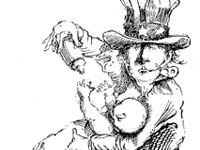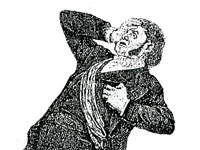Ink Regret
Summer is the season when skin is on full display, revealing tattoos often hidden from view the rest of the year. But what if you’ve had a change of heart about that heart you’re sporting on your shoulder? Laser technology is the answer—and a few local businesses are using it in charitable ways to change people’s lives for the better.
Summer 2013

On a busy afternoon in Sinners and Saints tattoo shop on South Highland Avenue in Shadyside, there is a distinct hum. It’s the whirr of electric needles pulsing at 15 times a second from what are essentially modified doorbell buzzers—a technology using electromagnets that has remained the same since the 1800s.
Five full-time tattoo artists concentrate on their work while chatting with their clients who have selected a piece of artwork for display on their hand, arm, chest, shoulder, back, or elsewhere. By pressing on a foot pedal, the artists control their needles that will deliver the ink about one millimeter below the surface of the skin.
The shop is well known for its active walk-in business and famous regulars. Rapper Wiz Khalifa, a Pittsburgh Allderdice graduate, stops by frequently with his entourage and has most of his work done by tattoo artist Mad Max and owner Todd Porter. And hip-hop superstar Mac Miller from Point Breeze sat with Mad Max for a John Lennon portrait on his right arm and with Michael Monack (aka the elusive and acrobatic graffiti writer Mook) to have his birth year in Roman numerals put on his hand.

Sinners and Saints and our other seemingly countless local tattoo shops are all part of the $1.65 billion tattoo industry.
Right: At Sinners and Saints in Shadyside, Michael Monack applies a tattoo to a customer.
Some 45 million Americans—an estimated one in five adults—have at least one tattoo, according to the Pew Research Center. Clearly they’ve gone mainstream; even Barbie now has tattoos.
“I’ve tattooed everybody from drug dealers and gangsters to teachers at Winchester Thurston, cheerleaders, engineering majors, murderers, brain surgeons, and everything in between,” Monack says. “It’s such a broad spectrum, it’s insane.”
A 2012 Harris poll determined—perhaps surprisingly—that 86 percent of people with tattoos have never regretted their decision; the poll says tattoos make people feel sexy, attractive, strong, spiritual, and rebellious.
But what if Mom was right when she said you’d rue that fire-breathing dragon that snakes up your back and curls its red flames around your bicep? Or what if you and Amanda aren’t in love forever after all, despite what it says on your forearm?
Luckily, for the other 14 percent of people who have felt “tattoo remorse,” there is a safe, highly effective option using laser technology to reverse what may have seemed like a permanent decision.
Bridget Miller, a certified laser technician and owner of East Side Laser Center in Shadyside, has been removing tattoos since 2006. This year, she will see approximately 280 patients for tattoo removal, which requires multiple appointments spaced six to eight weeks apart and can cost far more than the price tag of the original ink.
“I’ve removed tattoos from surgeons, lawyers, law students, bankers, stay-at-home moms—I do them all,” Miller says. “They are tired of them!”
The $65,000 laser system she uses delivers infrared light aimed at the embedded ink for extremely short pulse durations of just three nanoseconds, so as not to burn or scar the surrounding tissue.
“The laser penetrates to the deepest part of the dye, about a millimeter down, and starts to shatter it into miniscule pieces, which are then flushed out through your lymphatic system,” Miller explains.
Laser removal is the standard of care today for tattoo removal, but it’s not foolproof. Even after the final treatment, a slight shadow or “ghosting” of the tattoo may still remain for some clients.
Rhonda (who only wanted to use her first name), 43, works in Shadyside and is a regular client of Miller’s. After her seventh laser treatment, she is about halfway through the process of removing a tattoo “of a spiritual nature” she got on her wrist a year ago.
“Shortly after I got the tattoo, I realized that wasn’t the best professional decision I could have made because in my administrative role, my company has a policy of requiring that it be covered up and I didn’t want to do that,” she says.
Everyone’s pain tolerance varies, but Rhonda says the laser treatments feel like her skin is burning off. “It is the most painful thing I have ever gone through,” she says. “I’d rather give birth to 10-pound baby twins without an epidural.”

Brittany Oliver, an aesthetic laser specialist at The Skin Center in Shadyside, says patients who come to the medical spa for tattoo removal tend to fall into four categories: those who no longer care to have tattoos; those who would prefer more inconspicuous tattoos; those who have initials or names from previous relationships; and those coming out of college who find resistance in getting employment because of visible tattoos.
Left: Bridget Miller using a laser technique to remove a tattoo at her East Side Laser Center.
Among The Skin Center’s clients are those who have tried to enter the military, but are unable to meet regulations regarding visible tattoos. “We are currently offering free tattoo removal [for those patients], providing they furnish us a letter to that effect from their recruiting officer,” Oliver says.
Miller also gives back to the community by removing tattoos from gang members— pro bono. She started this work in 2009 when Kim Kaufman, then a clinical assistant with Western PA Child Care, asked her if she would treat a girl who had gang-related tattoos next to her eye that would preclude her from getting a job.
Kaufman, founder of the nonprofit Rethink My Ink, says it’s not about whether you have tattoos or not. “It’s the visible tattoos with negative connotations that are going to limit a person’s opportunities in life that I’m concerned about,” she says.
So far, Miller has done laser treatment on more than 100 gang members to remove their tattoos. “Normally, when someone has a tattoo removed, it costs roughly $200 per treatment and it takes 10 to 15 treatments,” says Kaufmann. “But Bridget has never said, ‘I can’t do it.’ That impresses me.”
In an essay to Rethink My Ink, a young man named Nafis Brown wrote about the effect he felt his gang-related tattoos were going to have on his college prospects: “As I sat in the college admissions office just last week, I felt extremely uncomfortable, as I often worry about what people think of my facial tattoos.”
Kaufman then referred him to Miller, who began treatments, and Brown’s academic adviser informed Miller that Brown is now “smiling from ear to ear” knowing that he will be able to move forward with his college plans.
“This is why I do what I do with these kids,” says Miller.
With many thanks to SHADY AVE magazine for granting me permission to reprint on my website.


